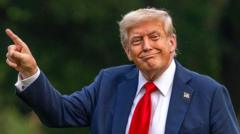How Will the US-Japan Deal Impact Asia and the Globe?

Understanding the Historic US-Japan Trade Agreement: Implications and Outcomes
In the realm of international trade, few agreements have garnered as much attention as the recent trade deal between the United States and Japan. Dubbed by President Donald Trump as the "largest trade deal in history," this agreement marks a significant turning point in U.S.-Japan relations and has far-reaching implications for the global economy. While some may argue that it's too early to label this deal as the largest, it undoubtedly stands as the most impactful agreement since the announcement of the so-called Liberation Day tariffs. As discussions unfold, it is essential to delve into the nuances of this agreement and explore its potential fallout, both regionally and globally.
The Economic Significance of Japan
Japan's position as the world's fourth-largest economy cannot be overstated. With a substantial influence on global trade dynamics, its economic health is critical not only for its own citizens but for economies worldwide. Japan's reliance on imports, particularly in energy and food, juxtaposed with its strong export capabilities—especially in sectors such as electronics, machinery, and motor vehicles—makes it a vital player on the world stage.
The United States stands as Japan's largest export market, making the success of this trade agreement crucial for both nations. Experts previously cautioned that the tariffs imposed by Trump could potentially subtract as much as a percentage point from Japan's GDP, pushing it towards recession. In light of this, the new agreement, which reduces tariffs, emerges as a beacon of hope for Japanese exporters, allowing them to operate more competitively in the U.S. market.
Tariff Reductions: A Double-Edged Sword?
One of the most noteworthy aspects of this agreement is the reduction of tariffs, particularly concerning the automotive industry. Japanese automakers such as Toyota, Honda, and Nissan are set to benefit significantly from decreased tariffs on their exports to the United States. Previously subjected to a hefty 27.5% tariff, this rate will now be slashed to 15%. This reduction not only makes Japanese vehicles more competitively priced against American and Chinese automakers but also provides a stronger foothold for Japanese manufacturers in the lucrative U.S. auto market.
However, this concession has raised concerns among U.S. automakers, who now face a 25% tariff on imports from their own facilities in Canada and Mexico. This disparity ignites a debate over fairness in trade practices and raises questions about the long-term implications for American automotive jobs and competitiveness. While Japan benefits from reduced tariffs, U.S. manufacturers may find themselves at a disadvantage, creating a rift in the relationship between these two trading partners.
Investment Opportunities: A Win-Win Scenario?
The agreement also stipulates that Japan will invest a staggering $550 billion in the United States. This financial commitment aims to build resilient supply chains in critical sectors such as pharmaceuticals and semiconductors. Such investments are expected to create jobs, enhance product quality, and foster innovation in both economies. For Japan, this deal represents an opportunity to solidify its economic presence in the U.S. while contributing to domestic job growth and technological advancement.
Impact on Agricultural Imports
Beyond the automotive sector, the agreement also includes provisions for increased purchases of U.S. agricultural products, particularly rice. This move is expected to alleviate some of the rice shortages in Japan but has raised concerns among local farmers about losing market share to American products. Balancing domestic agricultural interests with the benefits of international trade remains a delicate task for Japanese policymakers as they navigate these new trade waters.
Pressure on Other Nations
The implications of this deal extend beyond the borders of Japan and the United States. The lowered tariff rates set a benchmark for other countries, particularly those in Asia, who are currently negotiating trade agreements with the U.S. South Korea's industry minister has already indicated that he will closely examine the terms of the U.S.-Japan deal as he heads to Washington for crucial trade talks. The competition among Asian nations for favorable terms could intensify, particularly in sectors such as steel and automobiles, where Japan and South Korea are direct competitors.
Challenges for Smaller Economies
While larger economies may stand to gain from the U.S.-Japan trade deal, smaller nations like Cambodia, Laos, and Sri Lanka face significant challenges. These countries, which often rely heavily on manufacturing exports, have limited leverage in negotiations with the U.S. and may struggle to secure favorable terms. As larger economies fortify their positions, smaller nations risk being left behind in the evolving landscape of global trade.
Military Spending and Trade Discussions
Amidst the trade discussions, there have been reports indicating that the U.S. had called on Japan to increase its military spending. However, Japanese officials have clarified that the trade agreement does not include provisions related to defense budgets. This distinction is important as it highlights that the focus of the agreement remains firmly on economic collaboration rather than military commitments. Nonetheless, the U.S. retains its steel and aluminum tariffs at 50%, which could be seen as a point of contention in future negotiations.
The Future of Trade Relations
As the August deadline for tariff negotiations looms, the pressure is mounting on the U.S. to finalize as many trade agreements as possible. Countries may begin to seek more reliable partners and alternatives to traditional trading relationships. On the same day that the U.S.-Japan agreement was announced, Japan and the European Union pledged to collaborate more closely to counter economic coercion and address unfair trade practices. This acknowledgment of the need for global competitiveness showcases the interconnectedness of international trade and the ongoing pursuit of fair agreements.
Conclusion: The Road Ahead
The U.S.-Japan trade agreement stands as a significant milestone in the landscape of global commerce. With its potential to reshape trade dynamics, particularly in the automotive and agricultural sectors, the deal is bound to have a ripple effect across the globe. While there are benefits to be had, concerns remain regarding the implications for U.S. manufacturers, smaller economies, and the overall stability of international trade relationships. As these discussions continue to unfold, stakeholders must remain vigilant and adaptable to the changing tides of global trade.
Frequently Asked Questions
What are the main benefits of the US-Japan trade agreement?
The main benefits include reduced tariffs for Japanese exports to the US, increased investment from Japan into the US economy, and enhanced agricultural imports which can help address shortages. Additionally, the deal fosters innovation and job creation in both countries.
How does this agreement affect US manufacturers?
While the agreement lowers tariffs for Japanese automakers, it raises concerns for US manufacturers who face a higher tariff rate on imports from Canada and Mexico. This disparity may impact their competitiveness in the market.
What impact will this agreement have on smaller economies in Asia?
Smaller economies like Cambodia and Laos may struggle to secure favorable trade terms with the US, potentially leaving them at a disadvantage compared to larger economies that can negotiate better deals.
As we reflect on the implications of this landmark agreement, it's vital to consider how such trade dynamics will influence global economies moving forward. In a world where trade relationships are continually evolving, what strategies should nations adopt to ensure sustainable economic growth?
#TradeAgreement #GlobalEconomy #USJapanRelations
Published: 2025-07-23 12:10:08 | Category: technology



